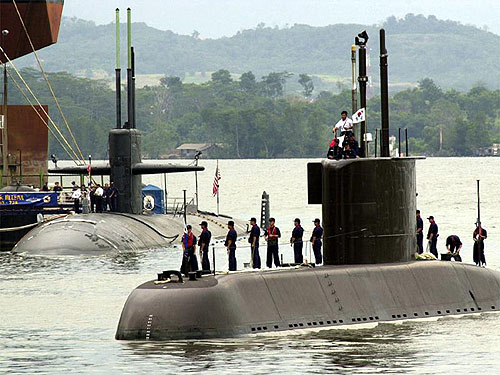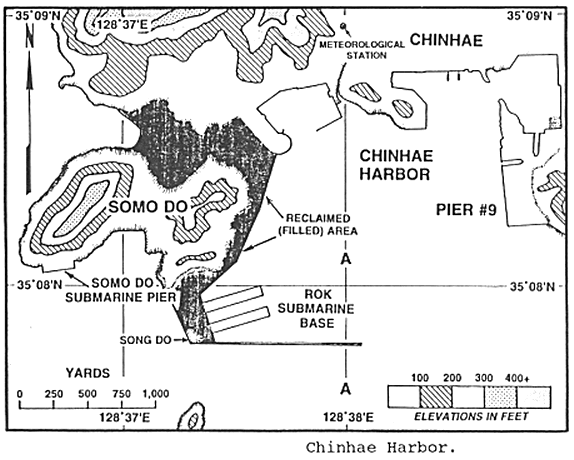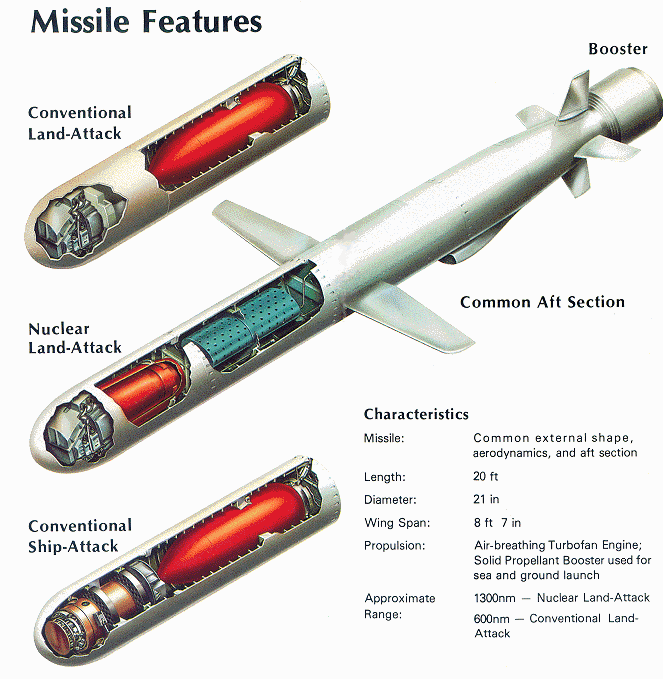American Nukes in South Korea 2006/08/08 1212

무슨 사이트인지 모르겠지만 검색을 하다보니 2003년 통일뉴스에 기고했던 글이 영어로 요약되어 번역되어 있었습니다. 원문을 싣습니다.
http://www.kimsoft.com/2003/us-nukes-sk.htm
American Nukes in South Korea
US military planners have kept up nuclear attack plans even after the 1992 and 1994 denuclearization agreements and Jinhae may be the main US nuclear weapons depot.
——————————————————————————–
Korea WebWeekly (Feb 28, 2003) — Gen. Richard Myers, the US Joint Chief of Staff, said yesterday in an NBC interview that, if President Bush and other command authorities decide to apply military forces to resolve special issues, the US forces are ready to implement flexible and effective forces. Gen. Myers added that North Korea is one of the targets for nuclear attacks. He said that the US maintains and updates all military options – including preemptive nuclear attacks – for North Korea.
Nicholas Kristof wrote in an article published by the New York Times today that the US military has drawn up a plan to attack North Korea’s nuclear facilities. The plan includes cruise missiles and high altitude massive e nuclear bombing raids on North Korean guns hidden along the DMZ that threaten Seoul. The Bush administration plans to take actions against North Korea this summer if diplomatic means fail to resolve North Korea’s nuclear crisis.
The United States has stationed special reconnaissance planes and submarines near Korea. The E6B planes and the missile chaser Invincible are equipped with wide area radars that can detect missile launches and nuclear tests. Placement of these assets and other military moves increase the potential for a war in Korea. The US military has never abandoned its plan for nuclear attacks on North Korea even after the denuclearization agreements signed in 1992 and 1994 with North Korea..
A South Korean investigative Lee Si-woo reporter has made public documentary evidence (“진해 미군기지는 핵정박소”) that indicate that the US military has nuclear weapons in South Korea at its naval base at Jinhae, South Korea and has been practicing nuclear attacks on North Korea in spite of the 1992 Nuclear-Free Declaration and the 1994 Agreed Framework.
The US navy has 71 submarines, all of which are nuclear. Mr. Lee has photos of three 1200-ton South Korean subs and one US submarine surfacing together near Kahduk island on January 28, 2003. The subs cruised on surface to Jinhae.
Photo: SSN-726 Helena and a South Korean Jangbo-class sub (front) in a joint exercise. Source:
During the US-Korea joint military exercise Foal Eagle that lasted from October 24th to 27th in 1995, a US nuclear submarine SSN-725 Helena played a key role. An American nuclear attack submarine La Jolla of the 7th Fleet collided with a South Korean fishing boat Young-Chang on February 11, 1998 near Jinhae. In the 38th Foal Eagle exercise in 1999, a nuclear warship Kushing participated.
From June 17th to 20th in 2000, a South Korean submarine SS-061 accompanied US SSN Houston (SSN-713) in nuclear attack practices in the Korean waters.
All of the US subs and nuclear surface ships are equipped with nuclear-tipped Tomahawk missiles and the presence of these vessels in Korea are clear violations of the 1991 denuclearization agreement based on President Roh Tae Woo’s statement that there was no nuclear weapons in South Korea. It is suspected that the US military has been keeping nuclear weapons at Ohsan and Gunsan airbases in addition to the Jinhae navy base.
Presented below are some of Mr. Lee’s discoveries. His findings prove that the United States may have been breaking the 1992 and 1994 agreements since the days the agreements were signed.
1. Jinhae – US Nuclear Sub Base
There have been rumors and assertions about the US nuclear weapons stored in South Korea by many reporters but Mr. Lee is the only one who has come out with documentary evidence. One of his findings is that Jinhae is the main nuclear sub base of the US 7th Fleet. All berths south of Suhmodo at Jinhae are reserved for nuclear subs. “By OPNAV instruction, the designated anchorage is the only anchorage nuclear ships may use. Due to the restricted size of the southern segment, nuclear ships are now limited to using the northern section.” – (http://www.globalsecurity.org/military/facility/chinhae.htm)
Map: The Jinhae harbor ()

The spot labeled “submarine pire” is where US nuclear subs used to be moored in the past. South Korean subs moor there there these days. US subs use the area between Somo-do and Song-do. Several large piers have been built since 1993 for the exclusive use of the US subs.
South Korean subs are 1200 tons, while US subs are 7,000+ ton giants. South Korea has 9 Jangbo-class subs that are 107-110 m long. It is easy to tell Korean subs from American behemoths.
Wolgan Mal was the first to disclose that the US nuclear subs are at Jinhae in 1992. The Mal article was based on eyewitness accounts of a liaison officer on active duty at the base collaborated by a former officer who had worked at the base. Upon publication of the Mal article, North Korea demanded an inspection of the base. South Korea vehemently denied this “baseless accusation” and refused to allow North Korea to inspect Jinhae, thus nullifying the mutual inspection clause of the 1992 agreement for nuclear-free Korea.

The US NSS Helena played a key role in the 1995 Foal Eagle military exercise. The US command ship Blue Ridge and nine other vessels including landing ships participated in the exercise. They practiced troop landing, anti-ship and anti-sub tactics and mine-sweeping. The US SSN La Jolla collided with a fishing boat on February 11, 1998, near Jinhae. Kahdok-do is one of the routes reserved for US nuclear subs.
In 1995, Japan and the United Stated conducted a joint military exercise called “Keen Edge”, in place of the Team Spirit that was cancelled in accordance with the 1994 Agreed Framework. “The November 1995 exercise ‘Keen Edge’ involved 26,500 troops from the US and Japan, including 400 planes and 27 ships, and was reportedly the largest ever joint exercise. Keen Edge may have been a substitute for the cancelled US-South Korean exercise `Team Spirit`, which was cancelled as part of the US-North Korean nuclear agreement. In June 1994, CALIFORNIA joined the USS KITTY HAWK battle group in the Western Pacific for the ship’s first deployment in five years. CALIFORNIA exchanged personnel with the Republic of Korea Navy for a combined exercise and with the Japanese Maritime Self Defense Force for ANNUALEX 06G and KEEN EDGE 95.” (http://www.globalsecurity.org/military/ops/keen-edge.htm)
In June 1994, the US nuclear carrier task force and South Korean warships conducted a joint exercise near Hawaii. Theoretically, Japan is free of nuclear weapons but the US military has been ignoring the nuclear-free Japan agreement. For example, US carrier Independence has been seen with tell-tale radiation warning signs on its deck. This carrier frequents Japanese ports. The US carrier Kitty Hawk, which was stationed at Yokosuka until recently, is powered by diesel engines. The Kitty Hawk left for Iraq and the nuclear carrier USS Carl Vinson is on its way to fill the gap left by Kitty Hawk. A nuclear carrier moored at Yokosuka violates Japan’s nuclear-free status. The Karl Vinson is expected to participate in the Foal Eagle scheduled to start on March 4th. North Korea may see Karl Vinson in the East Sea as a prelude to war and mount its own preemptive strikes.
Does Nuclear Subs in Korea Violate the Nuclear-Free Korea Agreement?
This agreement signed in 1992 states in part: “North and South agree not to test, make, acquire, possess, station, or use nuclear weapons.” The United Nations Command admits that nuclear subs frequent Korean ports but asserts that nuclear subs are not nuclear weapons per se, and so, visits of nuclear subs do not violate the nuclear-free agreement. The issue is whether nuclear subs themselves are nuclear weapons or not, aside from the question of nuclear missiles stored inside the subs.
The START1 agreement between the United Sates and the Soviet Union defines any system that is capable of launching nuclear weapons as a nuclear weapon itself. Nuclear subs that can launch nuclear missiles fall into this category. In fact, the United States has scrapped most of its Ohio-class nuclear submarines in accordance with START1. Stationing nuclear subs and nuclear surface ships equipped with nuclear-tipped Tomahawk missiles is a clear violation of the 1992 and 1994 agreements.
US Threats of Nuclear Attacks Violate the 1994 Agreement
The United States has agreed not to threaten to or to use nuclear weapons against North Korea. Military exercises that include simulated nuclear attacks clearly violate this agreement. Last September, Hans Christensen of the Nautilus Institute disclosed a secret US plan for preemptive nuclear strikes on North Korea. Ostensibly, Foal Eagle exercises are for defensive measures but active participation of nuclear subs and nuclear surface ships indicate that the true objective of Foal Eagle war games goes well beyond purely defense measures.
It has been claimed that the nuclear subs carry no nukes, but the fact of the matter is that they do carry nuclear-tipped Tomahawk missiles. For this reason, South Korea has denied that Jinhae is a naval base for American nuclear subs. North Korea asserts that the United States has violated its agreement to withdraw all nuclear weapons and weapons units from South Korea, to stop Team Spirit military exercises permanently, and that the 1994 Agreement was predicated on the United States living up to these agreements.
The US nuclear sub base at Jinhae proves that the United States has nuclear weapons in Korea in spite of President Roh Tae Woo’s declaration that no nukes existed in South Korea and senior Bush’s claim that the United States had removed all nuclear weapons from South Korea.
How to Verify Nuke Presence
There is no doubt that Jinhae is an American nuclear sub base. Mr. Lee has been unable to find the smoking gun for the existence of nuclear weapons inside the subs moored at Jinhae. The South Korean military claims that the subs do not carry nuclear weapons. Verifying nuke presence with certainty would required in-situ inspection of the subs, which the US navy would never allow. There are several indirect methods, however.
1) Jinhae Base Ammo Storage Depots
The whole of a mountain by the sea near Masan is surrounded by three layers of barbed-wire fences. There are 14 ammo depots on this mountain, and in addition, there are 10-plus additional ammo depots nearby. In accordance with the US military doctrine, the depots are shaped either like igloos or traditional magazines covered by a thick layer of dirt on top. The dirt tops are for camouflage and the walls are made of thick reinforced concretes.
Each depot is identified by a red octagonal sign with the digit 1 written on. What does this mean? The US Defense Ministry handbook lists ‘fire symbols’. The symbols fall into four classes: 1.1 is for mass destruction weapons, 1.2 is for explosives with fragments, 1.3 is for mass fire, and 1.4 for moderate fire. The symbols are required to be displayed for the benefit of firefighters in case of fire. The symbols tell the fire fighters how best to suppress the fire at a given depot.
The US Defense Dept has strict rules (“National Stock Number”) on the color and shape of the fire symbols. Class 1.1 is an octagonal on an orange background with the number “1″. Class 1.2 is in an X shape with the number 2 on an orange background, class 1.3 is an inverted triangle with the number 3, and class 1.4 is in a diamond shape with the number 4.
Class 1.1 includes high explosives. The US Army handbook on ammos (FM4-30.13) indicates that class 1.1 is for the most destructive munitions. The handbook states that all non-nuclear high explosive ammo depots must display the 1.1 fire symbols all around. It lists a number of exceptions, however: “The symbols will be removed, covered, or reserved if the explosives or chemical agents are removed from a facility or location.. Fire symbols are not required on individual structures used to store, maintain, or handle nuclear weapons or component.” (http://www.army.mil/usapa/epubs/pdf/p385_64.pdf ,, page 14)
In another word, if an ammo depot has no fire sign, then it is either empty or has nuclear weapons. If an igloo ammo depot is observed to remove fire signs or shows no fire signs, it is probable that the depot has nuclear weapons. The ammo depots at Jinhae that show octagonal fire signs may store Tomahawk missiles with conventional explosives. It should be said that Tomahawks are designed such that their warheads can be changed easily, and so, mounting nuclear warheads on Tomahowks would present no problems. A simplified diagram of Tomahawk missiles is given below.
Source –
The US SSN-701 (La Jolla) that collided with a fishing boat in 1998, the US SSN-725 (Houston) that participated in the 2000 joint exercise, and the US SSN-713 (Helena) are all Los-Angeles class nuclear submarines, for which Tomahawk missiles are the primary attack weapons
If verification inspections are to be done by the Korean National Assembly or other organs, the octagonal ammo depots at Jinhae should be on the top of their list.
Ammo Depots at US Air Force Bases in Korea.
There are US Air Force ammo depots at Hwangu near Songtan. The depots belong to the Ohsas airbase. There are 19 igloo depots and two above ground magazines. More igloo depots are under construction. Are there any nukes hidden in these depots?
Hans Christnsen of the Nautilus Institute obtained secret documents through FOIA. These documents show that the US military has practiced nuclear preemptive strikes on North Korea even after the 1994 Agreed Framework was signed. In June 1998, an F-15 squadron left the Seymore airbase in North California. The planes dropped BDU-38 practice nuclear bombs on a bombing range in Florida. The BDU-38 bombs are exact replicas of the nuclear bombs carried on B61 nuclear bombers.
The US Air Force manual AFMAN91-201 sets forth safe procedures for storing and transporting missiles, explosives and nukes. Site planners of ammo depots and airbases must follow these procedures. The Ohsan airbase had nuclear weapons at one time and maintains the same status as the Seymore airbase in California. A former US Air Force officer said:
“The inspectors performed a Phase 2 inspection. It tested war fighting capability. We simulated fighting a war in Korea, using a Korean scenario. This included chemical attacks to protect against using full chemical gear [sic]. The scenario was developed to lead us into the Nuclear Surety Inspection. This simulated a decision by the National Command Authority about considering using nuclear weapons. So we went into our NSI phase. We identified aircraft, crews, and [weapon] loaders to load up tactical nuclear weapons onto our aircraft. When that phase was terminated, The last phase of the exercise, the employment phase began.” http://www.nautilus.org/nukestrat/USA/NSNF/4fw98ex.pdf
Nuclear safety inspection and nuclear safety exercises are conducted per specific attack targets. What targets? The document states: “The 4th Fighter Wing’s combat mission was to support the Southeast Asia Operational Plan (OPLAN)”. The OPLAN has several war scenarios: #5051 for a Soviet invasion of Hokkaido, #5052 for war in Japan, #5053 for central east, and #5027 for war in Korea. The OPLAN was based on the US war doctrines of 1980. The plan calls for tactical nukes on fighter planes.
The US nuclear war doctrine is: “US policy concerning nuclear warfare is to deter it by maintaining a strong nuclear capability and, if deterrence fails, to terminate the conflict at the lowest possible level of violence consistent with national and allied interests. The US position is that deterrence is achieved if the threat assesses the outcome of war to be so uncertain and so debilitating under any circumstances that the incentive for initiating a nuclear attack is removed. This policy does not preclude the first use of nuclear munitions by US forces.”
This policy has been reaffirmed several times by the Bush Administration. The OPLAN 518, although formulated for military exercises, clearly includes nuclear attacks on North Korea. (See http://www.globalsecurity.org/military/library/policy/dod/oplan9518/CFCIIOPSM.DOC) The Perry-Lee Yang Ho joint statement of 1995 clearly states that the US will mount nuclear attacks in case of war in Korea.
In light of the above facts, it is plausible that US airbases in Korea have nuclear weapons on site. Mr. Lee had no way of checking out ammo depots at the US airbases in Korea. If inspections are to be done by Seoul government organs, ammo depots at US Air Force bases should be on the top of their list.
Mr. Lee is a photographer and an investigative reporter. While pursuing his profession, he ran into ‘nuclear’ evidence. North Korea claims that the United States has been continuing nuclear war games against North Korea even after the 1994 Agreed Framework. It is not clear what evidence North Korea has, but Mr. Lee’s own investigation seems to show that North Korea’s claim is not without some merits.